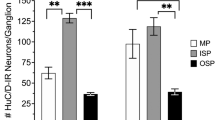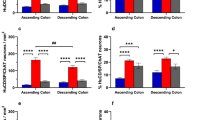Abstract
Lipofuscin, an autofluorescent age pigment, occurs in enteric neurons. Due to its broad excitation and emission spectra, it overlaps with commonly used fluorophores in immunohistochemistry. We investigated the pattern of lipofuscin pigmentation in neurofilament (NF)-reactive nitrergic and non-nitrergic human myenteric neuron types. Subsequently, we tested two methods for reduction of lipofuscin-like autofluorescence. Myenteric plexus/longitudinal muscle wholemounts of small intestines of five patients undergoing surgery for carcinoma (aged between 18 and 69 years) were double stained for NF and neuronal nitric oxide synthase (nNOS). Lipofuscin pigmentation patterns were semiquantitatively evaluated by using confocal laser scanning microscopy with three different excitation wave lengths (one for undisturbed lipofuscin autofluorescence and two for specific labellings). Two pigmentation patterns could be detected in the five NF-reactive neuron types investigated. In nitrergic/spiny as well as in non-nitrergic/stubby neurons, coarse, intensely autofluorescent pigment granules were prominent. In non-nitrergic type II, III and V neurons, a fine granular, diffusely distributed and less intensely autofluorescent pigment was obvious. After incubation of wholemounts in either CuSO4 or Sudan black B solutions, unspecific autofluorescence could be substantially reduced whereas specific NF and nNOS fluorescence remained largely unaffected. We conclude that NF immunohistochemistry is useful for morphological representation of subpopulations of human myenteric neurons. The lipofuscin pigmentation in human myenteric neurons reveals at least two different patterns which can be related to distinct neuron types. Incubations of multiply stained whole mounts in both CuSO4 or Sudan black B are suitable methods for reducing autofluorescence thus facilitating discrimination between specific (immunohistochemical) and non-specific (lipofuscin) fluorescence.



Similar content being viewed by others
References
Boldrini R, Biselli R, Santorelli FM, Bosman C (2001) Neuronal ceroid lipofuscinosis: an ultrastructural, genetic, and clinical study report. Ultrastruct Pathol 25:51–58
Braak H (1980) Architectonics of the human telencephalic cortex. Springer, Berlin
Braak H, Del Tredici K, Schultz C, Braak E (2000) Vulnerability of select neuronal types to Alzheimer’s disease. Ann N Y Acad Sci 924:53–61
Brehmer A, Schrödl F, Neuhuber W (2002) Correlated morphological and chemical phenotyping in myenteric type V neurons of porcine ileum. J Comp Neurol 453:1–9
Brunk UT, Terman A (2002) Lipofuscin: mechanisms of age-related accumulation and influence on cell function. Free Radic Biol Med 33:611–619
Chaudhary A, Sharma SP, James TJ (1995) Lipofuscin accumulation in neurons with restraint stress. Gerontology 41(suppl 2):229–237
Corns RA, Hidaka H, Santer RM (2002) Neurocalcin-α immunoreactivity in the enteric nervous system of young and aged rats. Cell Calcium 31:53–58
Costa M, Brookes SJH, Steele PA, Gibbins I, Burcher E, Kandiah CJ (1996) Neurochemical classification of myenteric neurons in the guinea-pig ileum. Neuroscience 75:949–967
Dogiel AS (1895) Zur Frage über die Ganglien der Darmgeflechte bei den Säugetieren. Anat Anz 10:517–528
Dogiel AS (1899) Ueber den Bau der Ganglien in den Geflechten des Darmes und der Gallenblase des Menschen und der Säugethiere. Arch Anat Physiol Anat Abt (Leipzig) 130–158
Eaker EY (1997) Neurofilament and intermediate filament immunoreactivity in human intestinal myenteric neurons. Dig Dis Sci 42:1926–1932
Furness JB (2000) Types of neurons in the enteric nervous system. J Auton Nerv Syst 81:87–96
Furness JB, Kunze WAA, Bertrand PP, Clerc N, Bornstein JC (1998) Intrinsic primary afferent neurons of the intestine. Progr Neurobiol 54:1–18
Gershon MD, Kirchgessner AL, Wade PR (1994) Functional anatomy of the enteric nervous system. In: Johnson LR (ed) Physiology of the gastrointestinal tract. Raven, New York, pp 381–422
Goyal RK, Hirano I (1996) The enteric nervous system. N Engl J Med 334:1106–1115
Hofmann SL, Das AK, Lu JY, Wisniewski KE, Gupta P (2001) Infantile neuronal ceroid lipofuscinosis: no longer just a “Finnish” disease. Eur J Paediatr Neurol 5(suppl A):47–51
Itoyama Y, Goto I, Kuroiwa Y, Takeichi M, Kawabuchi M, Tanaka Y (1978) Familial juvenile neuronal storage disease. New disease or variant of juvenile lipidosis. Arch Neurol 35:792–800
Mann PT, Southwell BR, Ding Y-Q, Shigemoto R, Mizuno N, Furness JB (1997) Localisation of neurokinin 3 (NK3) receptor immunoreactivity in the rat gastrointestinal tract. Cell Tissue Res 289:1–9
Phillips RJ, Kieffer EJ, Powley TL (2003) Aging of the myenteric plexus: neuronal loss is specific to cholinergic neurons. Auton Neurosci 106:69–83
Pompolo S, Furness JB (1998) Quantitative analysis of inputs to somatostatin-immunoreactive descending interneurons in the myenteric plexus of the guinea-pig small intestine. Cell Tissue Res 294:219–226
Porta EA (2002) Pigments in aging: an overview. Ann N Y Acad Sci 959:57–65
Portbury AL, Pompolo S, Furness JB, Stebbing MJ, Kunze WAA, Bornstein JC, Hughes S (1995) Cholinergic, somatostatin-immunoreactive interneurons in the guinea pig intestine: morphology, ultrastructure, connections and projections. J Anat 187:303–321
Porter AJ, Wattchow DA, Brookes SJH, Costa M (1997) The neurochemical coding and projections of circular muscle motor neurons in the human colon. Gastroenterology 113:1916–1923
Porter AJ, Wattchow DA, Brookes SJH, Costa M (2002) Cholinergic and nitrergic interneurones in the myenteric plexus of the human colon. Gut 51:70–75
Schnell SA, Staines WA, Wessendorf MW (1999) Reduction of lipofuscin-like autofluorescence in fluorescently labeled tissue. J Histochem Cytochem 47:719–730
Song Z-M, Brookes SJH, Ramsay GA, Costa M (1997) Characterization of myenteric interneurons with somatostatin immunoreactivity in the guinea-pig small intestine. Neuroscience 80:907–923
Stach W (1989) A revised morphological classification of neurons in the enteric nervous system. In: Singer MV, Goebell H (eds) Nerves and the gastrointestinal tract. Kluwer, Lancaster, pp 29–45
Stach W, Krammer H-J, Brehmer A (2000) Structural organization of enteric nerve cells in large mammals including man. In: Krammer H-J, Singer MV (eds) Neurogastroenterology from the basics to the clinics. Kluwer, Dordrecht, pp 3–20
Terman A, Brunk UT (1998) Lipofuscin: mechanisms of formation and increase with age. APMIS 106:265–276
Wade PR (2002) Aging and neural control of the GI tract. I. Age-related changes in the enteric nervous system. Am J Physiol Gastrointest Liver Physiol 283:G489–G495
Wood JD, Alpers DH, Andrews PLR (1999) Fundamentals of neurogastroenterology. Gut 45(suppl II):6–16
Acknowledgements
The excellent technical assistance of Karin Löschner, Stephanie Link and Hedwig Symowski is gratefully acknowledged. This work was supported by Deutsche Forschungsgemeinschaft (BR 1815/3).
Author information
Authors and Affiliations
Corresponding author
Rights and permissions
About this article
Cite this article
Brehmer, A., Blaser, B., Seitz, G. et al. Pattern of lipofuscin pigmentation in nitrergic and non-nitrergic, neurofilament immunoreactive myenteric neuron types of human small intestine. Histochem Cell Biol 121, 13–20 (2004). https://doi.org/10.1007/s00418-003-0603-7
Accepted:
Published:
Issue Date:
DOI: https://doi.org/10.1007/s00418-003-0603-7




